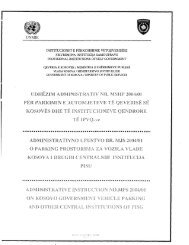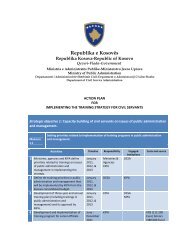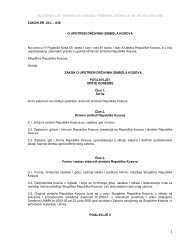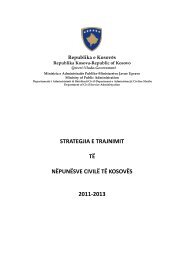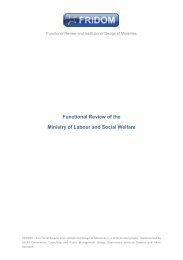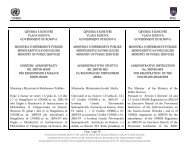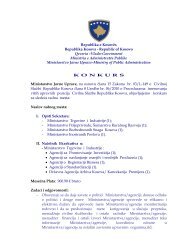Download
Download
Download
You also want an ePaper? Increase the reach of your titles
YUMPU automatically turns print PDFs into web optimized ePapers that Google loves.
an environment where corruption levels are a problem. The World Bank report noted four factors often<br />
associated with successful health insurance systems: 10<br />
The presence of fair competition in the market and an effective regulatory framework<br />
The degree of public trust in public institutions<br />
The effectiveness of political processes<br />
The presence of an organized civil society that demands accountability in society.<br />
These are difficult conditions to establish in developing countries, particularly when the level of income per<br />
capita is low and the population is small. The entry and exit barriers for providers are very large in small<br />
countries, notably for hospital and related clinical support services requiring considerable capital and HR<br />
investments. Not all these conditions are in place in Kosovo and would take considerable resources, time<br />
and other changes to achieve. The capability required to operate a successful health insurance model<br />
spans some very complex areas and requires staff with skills that are in demand in the labour market, such<br />
as governance, management, accounting, financial management, IT, contracting, investment, risk<br />
management, economic analysis and other policy analysis skills. Given that the MOH is in the very early<br />
stages of developing policies, plans and capability related to health insurance, it can be assumed that the<br />
movement to a full health insurance model is unlikely to be achieved in the next three to five years.<br />
Purchaser/provider split<br />
Even if the MOH does not proceed to a full health insurance model in the medium term, there are many<br />
functions and capabilities that could be developed to improve the efficiency and delivery of health services.<br />
If a purchaser/provider split as discussed in the World Bank report is considered feasible, then this<br />
development can be part of the progression to health insurance or an improvement in its own right, whether<br />
or not the health insurance model is adopted.<br />
In a purchaser/provider split the purchaser/funding functions could be undertaken by the Ministry of Health<br />
(see Appendix G for a fuller discussion of this). The Ministry of Health could have the role of contracting for<br />
the basic health package that can be financed from the government budget, through contracting with a mix<br />
of government and private providers, using the health budget provided by the government. It can develop<br />
many of the capabilities required for a health insurer, but tailored to its role as a government<br />
funder/purchaser of health services, rather than a full blown health insurer processing claims and managing<br />
revenues from a variety of sources. 11 The essential difference is that it would fund or purchase services<br />
and providers would manage demand according to the contracts and funding they received, rather than the<br />
insurer managing the demand through direct management of the claims.<br />
The roles of the MOH under a purchaser/provider split would move away from having such direct control<br />
over the providers to one of policy, funding, regulation, and monitoring, including monitoring of health status<br />
and results from the insurer (or similar entity) and aspects of performance of providers where the MOH has<br />
a direct monitoring role such as compliance with licensing requirements. Note that the insurer (or similar<br />
entity) would take on some monitoring functions of providers relating to the performance expected under<br />
the contracts.<br />
Under a purchaser/provider split the hospitals and some other providers that report to the MOH would be<br />
granted more flexibility to manage resources in return for being accountable for their performance as<br />
discussed in Appendix G. Currently the hospitals report directly to the PS of the MOH, and while they have<br />
some autonomy in budget execution, they are part of the MOH budget process. As an example of the<br />
decision rights of the MOH compared to a hospital, the following situation exists for the Kosovo University<br />
Clinical Hospital:<br />
Formal reporting line is to the PS of the MOH<br />
10 Ibid, page 32.<br />
11 Ibid, page 23 provides various examples of health insurance and similar arrangements, including Lithuania which has a similar<br />
model to the purchaser/provider model described in this paragraph. See also page 86 for a discussion of various models in OECD<br />
and transition countries.<br />
20



